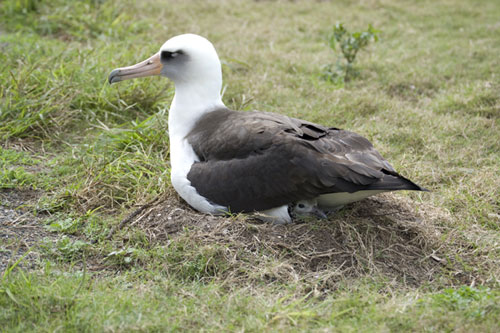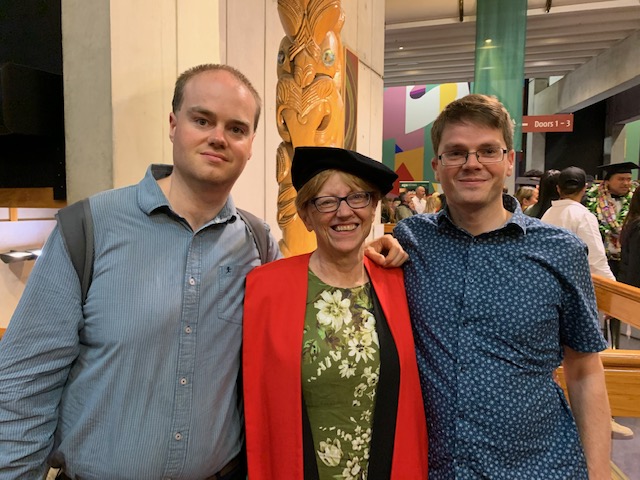The inaugural World Albatross Day (‘WAD2020’) will take place on 19 June next year, with the theme “Eradicating Island Pests”. The theme was chosen in part because next year will see an attempt to eradicate the House Mouse Mus musculus on Gough Island in the South Atlantic by the Gough Island Restoration Programme. GIRP is being led by the Royal Society for the Protection of Birds (RSPB) along with 12 governmental and non-governmental partners. The intention is to drop poison bait by helicopter over the whole island during the austral winter months of June to August.
The three albatross species that breed on Gough are all at risk to mice, most notably the near-endemic and Critically Endangered Tristan Albatross Diomedea dabbenena, where attacks on chicks in winter have massively lowered breeding success over the last two decades at least. More recently mouse attacks on breeding adults have been recorded, as well on chicks and adults of the Endangered Atlantic Yellow-nosed Albatross Thalassarche chlororhynchos. Both threatened species are illustrated on ACAP’s recently released ‘WAD2020’ poster by award-winning illustrator, Owen Davey.
ACAP Latest News has been in touch with several members of GIRP’s field team to gain their thoughts on the crisis in albatross conservation and the value of a World Albatross Day ahead of the planned eradication exercise.

New Zealander and island pest eradication expert Pete McClelland (left) is GIRP’s Operations Manager and will lead the field team, travelling to the island in May. He writes to ALN: “Albatross represent everything that is special about the Southern Ocean. From the impressive size of the great albatrosses as they glide effortlessly across thousands of kilometres of ocean to the haunting cry of a Light mantled Albatross as it undertakes its courtship flight. It is impossible not to be moved by these birds. To lose them is to lose part of our soul. World Albatross Day reminds us of just how important they are and why we must work to protect them.”
Three GIRP team members, Chris Jones, Alexis Osborne and Michelle Risi are already on Gough, where they are monitoring the seabirds, recording attacks by mice and helping prepare for the arrival of the main eradication team next year.

GIRP field team members, Chris Jones, Alexis Osborne and Michelle Risi display their WAD banner on the edge of the Gonydale Tristan Albatross monitoring colony on Gough Island
Chris writes to ALN: “Until relatively recently I did not know what albatrosses were, and I think most people do not know much about them. Learning of this wonderful group of birds and studying them over the past few years has infinitely enriched my life. If more people learn about albatrosses, this world will be better for it.”
Alexis has also expressed his feelings: “To see an albatross soar the ocean so effortlessly is an awe-inspiring experience that one can only dream of joining them. Unfortunately, many of these magnificent birds are threatened and if we don't do anything about it we stand to rob future generations of such awe-inspiring experiences. World Albatross Day is a great way to
give a voice to those that cannot speak.”
Michelle also feels strongly: “Working with albatrosses has changed my life, so now I am working to change theirs. I hope World Albatross Day can make people feel for albatrosses the same way they do for penguins. They are equally deserving of our awe and attention and are in desperate need of action as they face a conservation crisis.”


Is Two RSPB conservation scientists who form part of the GIRP team are Steffen Oppel (left) and Antje Steinfurth (right). Steffen writes: “Every day of the year at least one albatross is killed somewhere in the world by a fishing hook or an invasive animal that people brought to a remote island. World Albatross Day can remind us what harm our actions inflict on the greatest ocean wanderers.”
Antje’s comment follows: “World Albatross Day not only celebrates these magnificent ocean voyagers but also creates much needed awareness of their precarious conservation status. Whereas some threats albatrosses face can be addressed by boots-on-the-ground conservationists, others cannot. The protection and preservation of albatrosses ultimately is a shared mission on an international scale and it is incumbent on the international community to play an increasingly active role to ensure their populations will thrive into the future.”
The eradication campaign gets underway in mid February when the New Zealand-registered yacht Evohe is scheduled to leave Cape Town for Gough with GIRP team members aboard. ACAP Latest News will post updates on progress as information come to hand.
John Cooper, ACAP Information Officer, 18 December 2019


 English
English  Français
Français  Español
Español 






